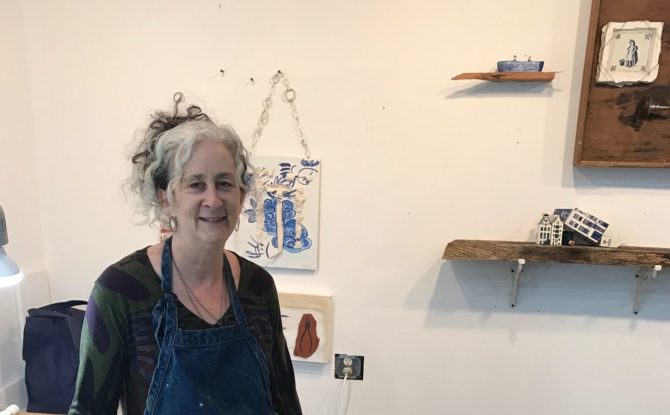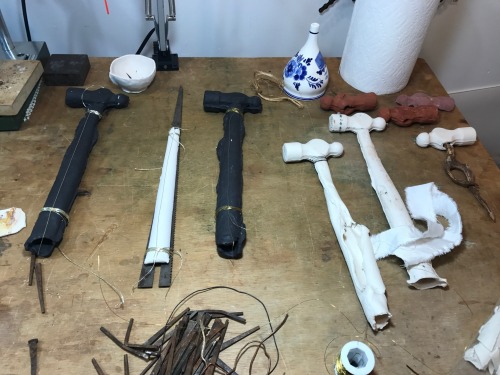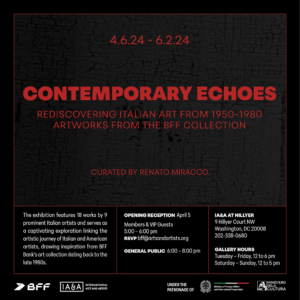
Measuring the Weight of Longing: Q & A with Gayle Friedman
Gayle Friedman is an artist who was raised in Birmingham, Alabama. She lives and works in Washington, DC. For the past decade she’s been a jeweler, teacher, and the founder of Studio 4903, a group art studio space. Friedman received a DC Commission on Arts and Humanities Fellowship Award in 2017. In addition to her solo exhibition at Hillyer, Friedman also has work in the exhibition “Intimate Gathering” opening June 2, at WAS Gallery in Bethesda, MD. Friedman is an artist in residence at Red Dirt Studio in Mt. Rainier, MD.
You often present your ceramic work in tableaus inside boxes, much like jewelry. How has making jewelry informed your work?
I actually see a lot of jewelry in my work—some of it shows up in the techniques I use that are taken directly from metalsmithing, such as incorporating soldered chains in a piece, or using rivets to cold-connect things. I also use sterling silver and even gemstones in some of my work. Several of the pieces in this show incorporate wire to attach or wrap things—all common in jewelry-making.
In this show I’m working with a lot of previously used things—I find their historical and emotional content very compelling. I do the same thing with a lot of my jewelry. In fact, I love working with people who want me to take something they’ve got and transform it into something more relevant or that they can use in a new way. Several years ago I made a series of reclaimed fur pieces that began when a friend gave me a collar from one of her grandmother’s fur coats.
Finally, I think I pay attention to minute details much as a jeweler does, which is easier to do when a piece is small. However, I’m excited to be going larger and breaking free of some of the size, weight and even balance restrictions necessary when making functional jewelry.

Tools are a dominant motif in your work. Can you talk a little bit about your fascination with tools in general?
The tools go way back to my early childhood. Summers in Alabama are hot and I’d go down beneath my grandparents’ house to the dirt-floored basement to cool off and play at Papa Izzy’s workbench. I can still smell it—that kind of musty, iron aroma. He owned a hardware store before the depression and had quite a collection of tools. Just the objects themselves fascinated me. I remember being especially fond of the vice and his hammers. After he died, dad got all of his tools and created a really cool shop in our basement, where I’d often go to seek refuge. Dad was always doing projects around the house but he never showed me and I never asked how to use any of his stuff. It sure made an impression on me, though.
And after he died, what I most wanted were some of his old tools. At the time I had no idea what I’d do with them. All of the work I’m doing now began when I made a mold of dad’s ball peen hammer and began casting clay replicas of it.
What does your process look like when making your Delftware pieces? Does your photography of decomposing and broken plant materials inform how you treat porcelain?
I studied Anthropology in college and did several digs in Alabama during and after school. I spent a lot of time in the dirt, searching for the tiniest pieces of information. Almost everything we found was broken.
Many of the things I make feel like artifacts, and while they’re not necessarily dirty, I often tear or break them because I figure that just about everything ends up that way. Sometimes I’ll break something on purpose and glue it back together again. Many of the delft pieces in my mom’s collection broke over the years, and one of my dad’s chores was to glue them back together. In fact, this week, a vase he had repaired broke apart again and I had to re-glue it. It was so strange to think that he was the last person to have paid close attention to this crack; his hands were the last to touch the glued surfaces and now I was revisiting them. It felt so intimate, like we were having a conversation.
I’m enamored with my compost pile and find the decay to be quite beautiful. The rust I use in many pieces is a part of that process of decay in metal. We tend to think of metal as dead, but I really like how inanimate materials also have a sort of life that shows up through time and their disintegration or exposure to oxygen.
Tell us about your experiences with Studio 4903. Does sharing studio space with other artists impact your work?
I am so happy to work in shared art studio spaces. I founded Studio 4903 12 years ago because I didn’t want to work out of my home. I wanted to be part of a community of people who I could problem solve with, bounce ideas off of, be inspired by. I also have a firm belief that many together can accomplish much more than an individual on her own. Interestingly, I’m now in two shared studio spaces! I’ve been doing an artist residency at Red Dirt for about a year and a half, and it’s there that I’ve expanded my process beyond creating jewelry.
I find it really interesting how working in proximity to others can affect my work in subtle ways: I’ll try a color of paint I’ve never used before, or tear something and realize that one of my studio mates tears and cuts a lot of her work. And then there’s the conversations we have, sometimes in structured meetings or critiques, but often over a quick lunch or chance encounter. The dialogue helps shape who I am as an artist. I’m curious by nature so I want to know what others think and feel—about what they’re doing as well as about my work. These moments give me ideas, things to incorporate or reject, often a new or better way of looking at my work. They can be very challenging and even crazy-making, but I love it all!

How has your work evolved over time? What are your next steps in your body of work?
Many people don’t know that I was making ceramic sculpture back in the 90’s. I got lured away from the studio to help found an alternative school, Fairhaven School, in Prince George’s County, where I spent 7 years. When I left the school I knew I wanted to immerse myself in a creative practice again, but didn’t really know where to begin. My ceramic pieces had begun large but had gotten smaller over the years, so it seemed natural to explore jewelry. I loved the idea that I could create these intimate art pieces that people would literally carry on their bodies. Early on I made more conceptual jewelry, such as a series on waste and luxury. One example from that series is a pair of plunger earrings made of silver and terra cotta clay, with a tiny diamond hidden up inside the clay part of the plunger—as if any plunger could tuck away something as precious as that! But I really wanted to have a larger audience for my jewelry, so I began making more functional, accessible work.
More recently I’ve realized that I have different kinds of questions I want to try and answer. That’s where I feel most engaged right now. I’m interested in how people in other cultures treat, use and discard family items and heirlooms. I’m going to spend time doing some research on that and see how I might be able to collaborate with anthropologists and artists.
I’ve also been interested in doing more mantel installations. I think there are lots of people who’ve stored things in boxes because they don’t want to throw them away, but don’t know what to do with them. I’d love to collaborate with them and their stuff—to open those boxes and reimagine those things in new ways.

